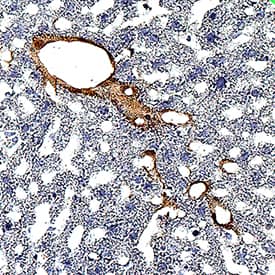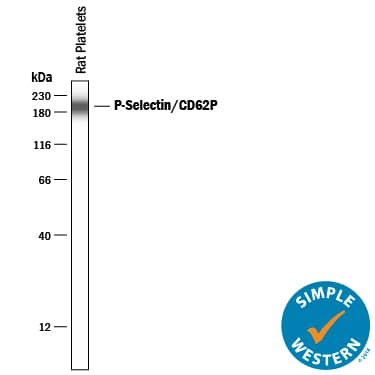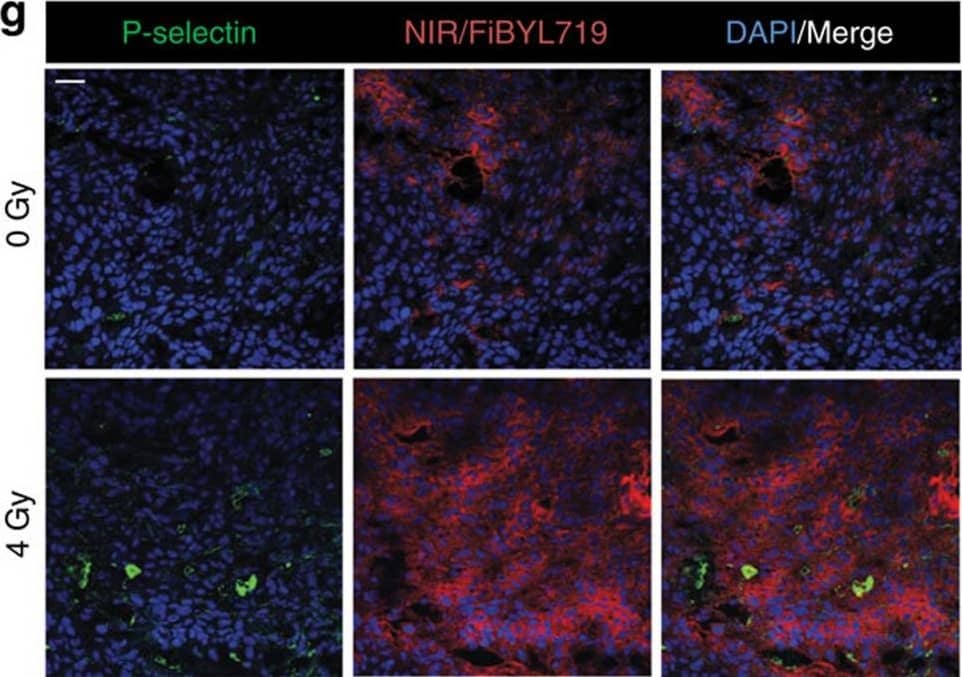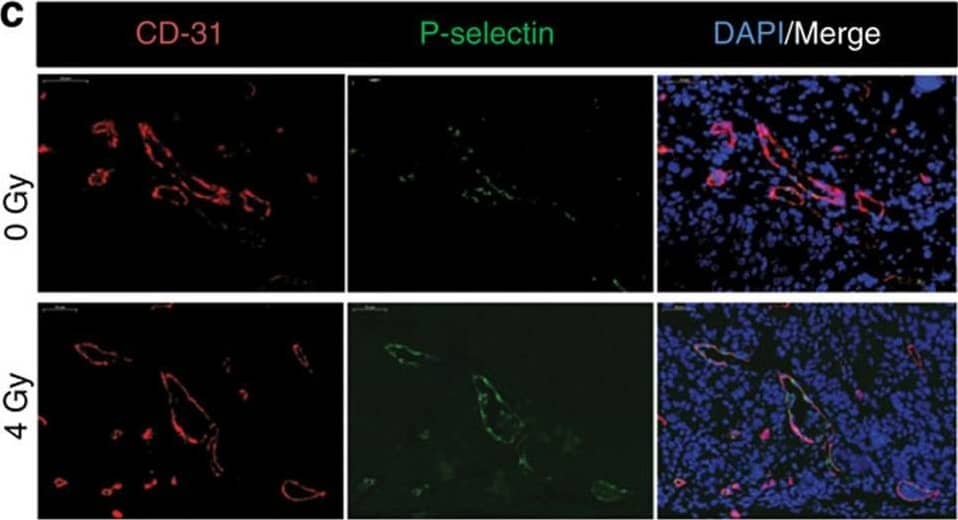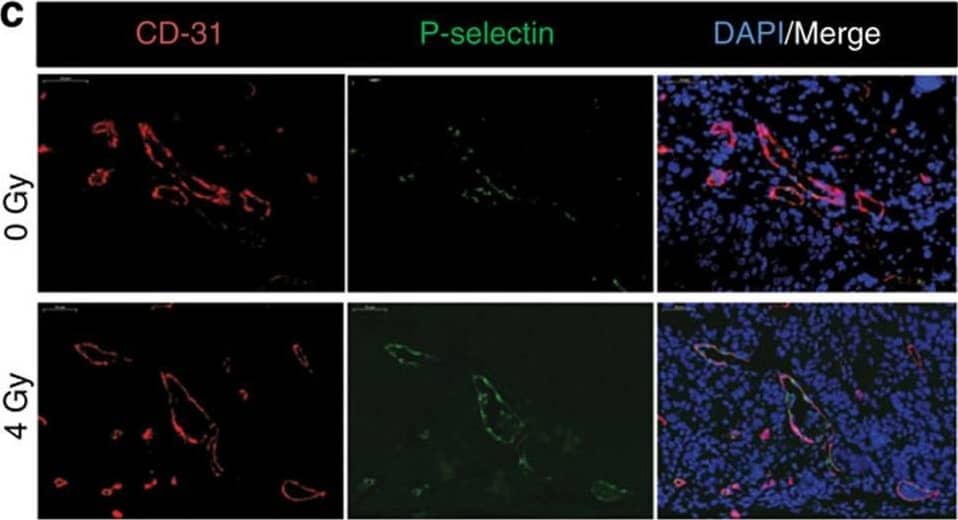Mouse/Rat P-Selectin/CD62P Antibody
R&D Systems, part of Bio-Techne | Catalog # AF737

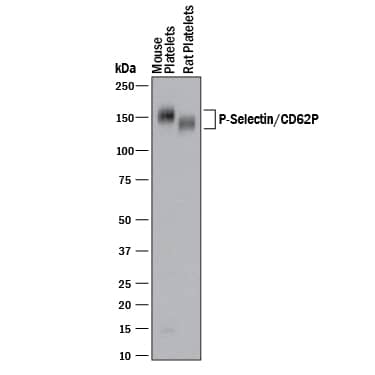
Key Product Details
Validated by
Species Reactivity
Validated:
Cited:
Applications
Validated:
Cited:
Label
Antibody Source
Product Specifications
Immunogen
Trp42-Ala709
Accession # Q01102
Specificity
Clonality
Host
Isotype
Scientific Data Images for Mouse/Rat P-Selectin/CD62P Antibody
Detection of Mouse and Rat P-Selectin/CD62P by Western Blot.
Western blot shows lysates of mouse platelets and rat platelets. PVDF membrane was probed with 2 µg/mL of Goat Anti-Mouse/Rat P-Selectin/CD62P Antigen Affinity-purified Polyclonal Antibody (Catalog # AF737) followed by HRP-conjugated Anti-Goat IgG Secondary Antibody (Catalog # HAF017). A specific band was detected for P-Selectin/CD62P at approximately 140-150 kDa (as indicated). This experiment was conducted under reducing conditions and using Immunoblot Buffer Group 1.P‑Selectin/CD62P in Mouse Liver.
P-Selectin/CD62P was detected in perfusion fixed frozen sections of mouse liver using Goat Anti-Mouse/Rat P-Selectin/CD62P Antigen Affinity-purified Polyclonal Antibody (Catalog # AF737) at 5 µg/mL for 1 hour at room temperature followed by incubation with the Anti-Goat IgG VisUCyte™ HRP Polymer Antibody (Catalog # VC004). Tissue was stained using DAB (brown) and counterstained with hematoxylin (blue). Specific staining was localized to endothelial cells. View our protocol for IHC Staining with VisUCyte HRP Polymer Detection Reagents.Detection of Rat P-Selectin/CD62P by Simple WesternTM.
Simple Western lane view shows lysates of rat platelets, loaded at 0.2 mg/mL. A specific band was detected for P-Selectin/CD62P at approximately 197 kDa (as indicated) using 20 µg/mL of Goat Anti-Mouse P-Selectin/CD62P Antigen Affinity-purified Polyclonal Antibody (Catalog # AF737) followed by 1:50 dilution of HRP-conjugated Anti-Goat IgG Secondary Antibody (Catalog # HAF109). This experiment was conducted under reducing conditions and using the 12-230 kDa separation system.Applications for Mouse/Rat P-Selectin/CD62P Antibody
Immunohistochemistry
Sample:
Perfusion fixed frozen sections of mouse liver
Simple Western
Sample: Rat platelets
Western Blot
Sample: Mouse platelets and Rat platelets
Reviewed Applications
Read 1 review rated 5 using AF737 in the following applications:
Formulation, Preparation, and Storage
Purification
Reconstitution
Formulation
Shipping
Stability & Storage
- 12 months from date of receipt, -20 to -70 °C as supplied.
- 1 month, 2 to 8 °C under sterile conditions after reconstitution.
- 6 months, -20 to -70 °C under sterile conditions after reconstitution.
Background: P-Selectin/CD62P
Mouse P-Selectin (GMP-140, LECAM-3, PADGEM, CD62P), a member of the Selectin family, is a cell surface glycoprotein expressed by activated platelets and endothelial cells. P-Selectin is translocated to the cell surface within minutes, from alpha granules of platelets or Weibel-Palade bodies of endothelial cells, following stimulation with thrombin, histamine, PMA or peroxides. P-Selectin binds to a 106 kDa protein present on myeloid cells, neutrophils, monocytes and lymphocytes, termed PSGL-1 (P-Selectin glycoprotein ligand-1).
P-Selectin plays a role in the adhesion of leukocytes and neutrophils to the endothelium. Acting in cooperation with L-Selectin, P-Selectin mediates the initial interaction of circulating leukocytes with endothelial cells that produces a characteristic ‘rolling’ of the leukocytes on the endothelium. This initial interaction is followed by a stronger interaction involving E-Selectin, and later ICAM-1 and VCAM-1, that leads eventually to extravasation of the white blood cell through the blood vessel wall into the extracellular matrix tissue.
Mouse P-Selectin cDNA encodes a 768 amino acid (aa) residue type I transmembrane protein with a 41 aa signal peptide, a 668 aa extracellular domain, a transmembrane domain and a short (35 aa) cytoplasmic domain. The extracellular domain has an NH2-terminal C-type lectin domain and an EGF-like domain followed by a series of complement factor A repeat homology domains. The extracellular domains of human and mouse P-Selectin share approximately 73% sequence homology.
References
- Kansas, G.S. (1996) Blood 88:3259.
- McEver, R.P. and R.D. Cummings (1997) J. Clin. Invest. 100:485.
Alternate Names
Gene Symbol
UniProt
Additional P-Selectin/CD62P Products
Product Documents for Mouse/Rat P-Selectin/CD62P Antibody
Product Specific Notices for Mouse/Rat P-Selectin/CD62P Antibody
For research use only
